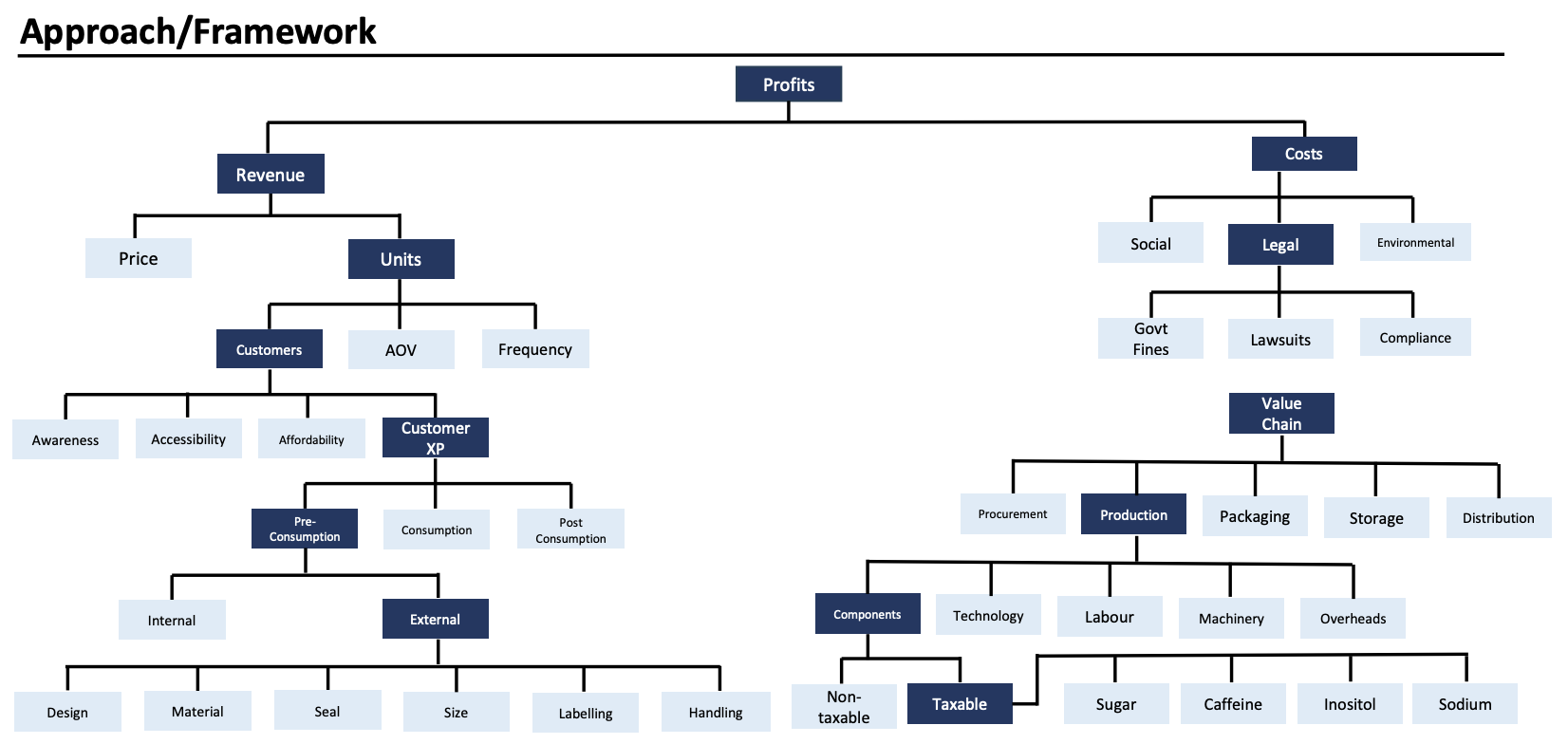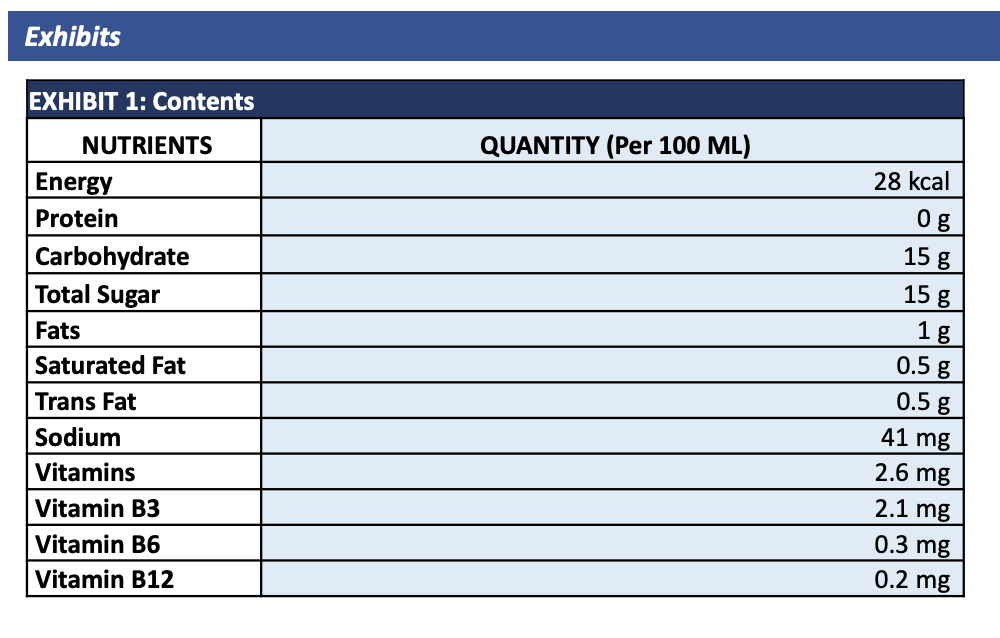What the foodie
Case Statement :
Your client Energyz is a beverage manufacturer in India and they have been facing a decline in
profits for the past 6 months. You are required to find the cause and provide recommendations for
the same.
Interview Transcript
Your client Energyz is a beverage manufacturer in India and they have been facing a decline in profits for the past 6 months. You are required to find the cause and provide recommendations for the same.
To begin with, I would like to understand the quantum of the decline and the parts of the value chain they operate in.
They have been facing a 20% decline in profits. The client manufactures, distributes and retails their products.
Do we have any more information on their distribution? Is it a pan-India distribution system or do they have any geographical concentration?
They distribute nationally.
Alright. How much competition does the client face and are their competitors also facing a decline in profitability?
There is majorly only 1 competitor and they have undergone only a 10% profit decline.
Okay. Lastly, I would like to know the product segments of our client and if any particular products have been facing this issue. If yes, which ones?
They sell a variety of products but the main concern is regarding their energy drinks.
Now that I have the requisite, I shall begin my analysis by looking at the two functions of profit – revenues and costs. Next, I will identify which of these is a problem and further look into the internal and external factors that may lead to a change in the revenue or the cost structure for the category. Would you like me to proceed in this way?
Sure. There has been both a decline in the client’s revenues and an increase in their costs. I’d like you to begin with the cost side and then proceed to the revenues of the client.
Accounting for a decline in profits for our competitor, can I assume that there is an industry-wide problem?
Yes, there is an industry-wide problem affecting the costs that are external to the firm.
Alright, external costs can be viewed as social costs, legal costs, and environmental costs. Is this a fair assumption?
Yes, it is. The increased costs seem to be due to the legal scenario of the F&B industry.
Understood. From an industry point of view, these costs can be due to government fines and penalties, compliance costs, or unpredicted lawsuits.
Good! Our client has been incurring huge expenses through government fines and penalties due to specific non-compliance or violation of regulations. Can you identify the root cause of paying penalties?
Absolutely. For this, shall I walk you through the value chain of a beverage manufacturing company and identify the problem therein?
Interesting. Go ahead.
The value chain of a beverage manufacturing firm can be broken down into procurement, production, packaging, storage, and distribution. Additionally, there might be transportation between these steps. Is there any step that I am missing that you would like me to focus on?
Quite accurate. Please proceed with the production costs of our client.
Producing energy drinks requires ingredients, labour, machinery, technology and other overhead expenses.
The components of the beverage have posed a problem here.
Since the costs lie within non-operating expenses, they can be associated with the pricing of the ingredients or the volume of the ingredients used. Additionally, including or omitting an entirely new raw material could have also triggered the regulations. Do we have any relevant information on any of these factors?
Yes, we do. The quantity of their ingredients and nutrients has committed an offence. Here are the contents of the energy drinks produced by our client : [Exhibit 1]
Ingredients – Carbonated Water, Sugar, Acidity Regulators (330, 331), Sequestrants (452(i), 385), Taurine, Caffeine (38 mg/100 ml), Preservatives(211, 202), Sweeteners (955, 950), Inositol, Vitamin Premix.
My awareness regarding the FSSAI standards and regulations is limited but sugar, sodium, caffeine, and inositol are harmful to the human body if consumed in huge amounts. Is there any difference in the composition of our competitor’s product?
Not at all. Their ingredients are the same as our client’s.
Then the only probable cause for a penalty is the exceeding limit as per regulations.
Yes, great work! The government has advised the sugar levels to be a maximum of 12 g per 100 ml compared to the previous 15 g per 100 ml whereas caffeine needs to now be limited to 35 mg per 100 ml as compared to the then 40 mg per 100 ml.
I believe that this is the reason why Energyz and its competitor have been facing losses. Should I proceed with the revenue side of the company to ascertain the rest?
Yes, please go ahead.
Okay. A manufacturing organisation’s revenue is determined by the selling price of its units sold and the number of units sold. Which of these factors have changed?
The price has remained constant but there has been a deduction in the number of units sold.
Alright. I can now see this as either an issue from the demand perspective or the supply side. Has there been a reduction in the supply of energy drinks or has the demand from the consumers decreased?
Supply has been the same over the years. Try to analyse the demand for the product.
Sure. Demand is essentially determined by the number of customers, their average order value and the frequency with which they purchase our products. So should I start with a particular segment?
Yes, The number of buyers has drastically reduced in the past 6 months for Energyz.
Okay. A customer interested in relishing our energy drink would first have to be aware of our product. Further, the accessibility of our product would greatly determine how they weigh in their options. Affordability is what will make our product stand out and then the customer experience is going to assure us of repeat purchases. Since our client is one of the two major players, has a pan- India presence and the prices are competitive, then it is safe to assume that awareness, accessibility and affordability would not be a problem. Am I headed in the right direction?
Good going. You are in the right direction. The client has been receiving feedback and reviews for the past few months.
I would like to break this customer journey of our product into 3 categories:- Pre Consumption, During Consumption, and Post Consumption. Which of these phases have received the most reviews? Also, are the reviews directing us towards an internal problem or an external one?
I need you to elaborate upon “internal” and “external”.
Sure, Sir. Internal would indicate to us that the problem lies within the product and external would tell us about the environment of consumption.
Well, the reviews mainly revolve around our product and that is not related to consumption or post-consumption.
Alright. If consumption and post-consumption are eliminated, will it be fair if I conclude that the problem lies within the exterior product and not the drink as consumption and the side effects of the drink post consumption also get eliminated?
Good observation. Continue with the exterior product.
That clarifies a lot. Hence, the product or packaging might be the problem. The potential problems that I see include the product design, packaging material, packaging size, sealing of the product, handling of the product, unclear labelling, and limited or misleading information. Have I pinned the answer here?
Bingo! The sealing of the bottle is a little problematic.
I see. Since this is a company-specific problem, is it safe to assume that the sealing of our competitor is hassle-free and more convenient to remove?
You are right. Our client’s products usually require you to have a bottle opener to consume the beverage which might not be available instantly. Hence, they prefer our competitor’s energy drink which earlier required a bottle opener but has now changed its cap seal which is easier to open. How do you suggest we manage all of this?
Sure, I would like to structure the recommendations into two parts. One details how the client can improvise on the packaging and the other for tackling the sudden change in the regulations:-
To address the packaging and revenue decline:- Research and understand the competitor’s seal.
Explore alternative materials to reduce costs and simultaneously improve customer experience.
Explore the option of redesigning the entire packaging to give a fresh and new look.
To address the change in government regulations:- Reformulation of the drink, including looking for artificial ingredients to replace sugar and alternative sweeteners. Diversify into other products that require less caffeine and sugar content but have a similar requirement for other ingredients. Develop a marketing strategy that educates and informs target customers of the product’s compliance with government regulations and improved health benefits.
Fine. We can now close the case.
Case Facts
- Change in government restrictions of caffeine and sugar components.
- Client faces a 20% decline in profits whereas competitors face a 10% decline in profits.
- The Upper limit on sugar and caffeine in drinks has been capped at 12g per 100 ml and 40 mg per 100 ml.
- The clients drink requires to be opened using a bottle opener.
Approach

Case Recommendation
- Explore alternative materials to reduce costs and simultaneously improve customer experience.
- Explore the option of redesigning the entire packaging to give a fresh and new look.
- Reformulation of the drink, looking for artificial ingredients to replace sugar and sweeteners.
- Diversify into other products that require less caffeine and sugar content but have a similar requirement for other ingredients.
Brownie Points
Product diversification to escape strategic interdependence due to duopoly.
Exhibits


